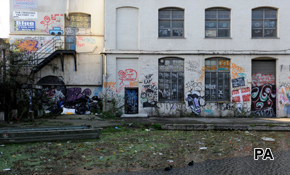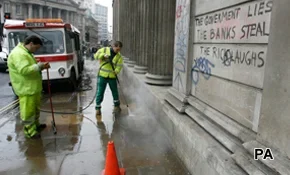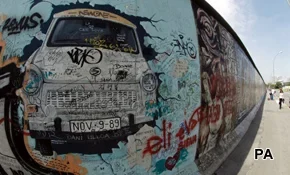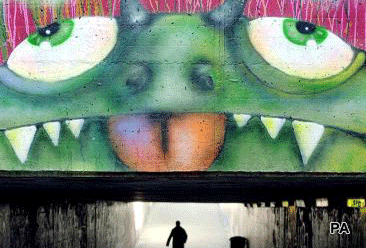Does graffiti symbolise a neighbourhood in decline, or should it be seen as valuable art? Join Labs panellists in the great graffiti debate
Graffiti ‒ an act of vandalism and a sign of a neighbourhood in decline?
Some would agree, but increasingly, this view is being challenged by the growing prominence of ‘street artists’ who create graffiti that many people would consider to be valuable works art.
Just last week, a collection of works by British graffiti artist Banksy sold for more than £400,000 at an auction in London, and graffiti stencils by the Russian street artist ‘Pavel 183’ have also sold for hundreds of thousands of pounds.
On the other hand, the usual perception of graffiti as a 'problem' persists: English Heritage reported recently that around 70,000 listed buildings are estimated to have been damaged in 2011 ‒ from, they cited, a combination of graffiti, urination and metal theft.
What are your views on graffiti? We asked Labs participants to have their say on the issue
Responses tended to represent one of two general opinions: panellists either felt that graffiti was largely an act of vandalism regardless of its type, or felt that in some situations, it can be acceptable and even seen as art. The responses we received made it clear that it is the content, style and message of the graffiti that matters.
Many people also suggested setting up designated areas to keep graffiti under control, while a few participants proposed new penalties for graffiti that is unmistakeably anti-social.

What do you think about graffiti? Join the debate by using Disqus below

Here's what our poll participants had to say...
1. All graffiti is vandalism
Argument 1: It makes an area look run-down
“It makes our country look untidy and not well kept” Susie B, Newcastle upon Tyne
“Graffiti makes an area look run-down and uncared for, somewhere where you would not like to shop or live” Anon
“Even when done well, which is very rarely, it looks awful. It makes an area look run-down; if these people are so keen on doing it they should do so on their own homes” Rosie S, Staffordshire
“It makes some areas look like war zones and the authorities should be more keen to remove it” Peter F, Surrey
Argument 2 - It is illegal
“Painting on someone else's/public property is illegal. Graffiti is an expression by individuals who lack a sense of personal ownership” Anon
“It is done illegally. People think they can just do what they like and get away with it” Julia F, Bicester
“No one has the right to deface public or private property” Bob E, Shropshire
“Disfigures the object(s) on which it is placed. It is criminal damage” Anon
Argument 3 - Others have to clean it up
“It invariably costs people, private companies and local authorities money to remove” Wayne, Hertfordshire
“I have suffered from tagging on my property. There is very little art to it that I can see and it is expensive to clear up” Anon

“It's mostly ugly and unsightly and damages someone’s property - plus the tax payer has to pay to clean it up” Anon
“Costs taxpayers money to clear and gives a bad image to places. Usually the person causing the graffiti is not a tax payer so they contribute nothing!” Aidan, Cornwall
2. Some graffiti is acceptable
Argument 1 - It can be artistic and improve the look of the area

“Very occasionally, graffiti can be a mini work of art which brightens up an otherwise boring wall” Anon
“Graffiti that is art, like well-drawn pictures that enhance a buildings plain wall is acceptable. If it is used to disguise an ugly piece of architecture or an eyesore is certainly going to enhance the area” Mikki T, Scotland
“An artist that has made use of a run-down building to create their art is in fact using his/her environment to its full potential. It is giving the building of neglect a new purpose” Anon
“Sometimes graffiti is used to paint murals in connection with youth club work etc. and helps cover untidy areas. This can brighten up the village or town” Anon
Argument 2 - It can be good, dependent on context
“Graffiti artists are talented so I enjoy looking at their work when it's in a place where people can appreciate it and it looks good rather than someone just spraying the bus stop as they go by” Anon
“It needs the right context and surroundings to earn respect in its own right, and not be seen as vandalism” Anon
“I think there needs to be a distinction between street art and graffiti or tagging. Street art can enliven drab areas of housing or the urban environment” Anon
“'Good' graffiti is art and can be enjoyed publicly. ‘Bad' graffiti is a picture of a phallus or a simple scribble, swear words or a pointless and usually misspelled note” Adam L, Lancashire
Argument 3 - It can carry an important message
“I can tolerate graffiti that has a sense of humour or irony and expresses a comment about society” Anon

“I think it can be an important form or artistic expression, often for socially excluded groups. I also think it can give young people a voice” Anon
“Some graffiti can be very powerful, and a worthwhile means of self-expression” Anon
“I think it is a way for people to make their feelings clear - often people who feel that society is not listening to their vocal complaints” Mrs S, Northamptonshire

What do you think about graffiti? Join the debate by using Disqus below

Follow and discuss: @YouGovLabs on Twitter









